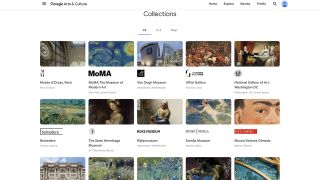
When you purchase through links on our site, we may earn an affiliate commission. Here’s how it works.

“When arts meets history” can describe the dynamic online platform known as Google Arts & Culture. With a wide array of cultural content, artifacts, and information, Google Arts & Culture provides an accessible and robust resource that teachers and students can use to elevate the teaching and learning experience. Moreover, Google Arts & Culture is free, so the use of a high-quality tool comes with no financial burden for teachers.
This sample Google Arts & Culture lesson plan demonstrates how it can be used across different subject areas and grade levels.
Subject/Topic: Varies
Grade Band: Elementary/Middle/High School
Learning Objectives: At the end of the lesson, students will be able to:
Provide students with an overview of how people, places, and events throughout history and in the present have impacted and impact society in some way. Then, walk students through some of those examples by going to the Google Arts & Culture site.
Tools and ideas to transform education. Sign up below.
By submitting your information you agree to the Terms & Conditions and Privacy Policy and are aged 16 or over.
You may want to start with the “Artists” option for the example, and choose a well-known person such as Vincent van Gogh so students can learn of the contributions he made to western art history. Once you click on Vincent van Gogh, you will be taken to 24 related stories and hundreds of images that can be viewed through augmented reality or even street view.
In addition to the “Artists” option, there is “Mediums,” “Art Movements,” “Historical Events,” “Historical Figures,” and “Places” that you can explore with students.
Once you have acclimated students to the Google Arts & Culture platform, have them decide on one event, place, or person on which to focus. Then, over several class sessions, provide time for them to explore every story, image, and other provided information about their chosen subject within Google Arts & Culture.
Be sure to encourage and guide students to read the content on each page, experience the 360 degree view and AR/VR options, as well as street view when applicable.
Once students have completed their exploration and research, they can put together their articulation of their learning. Instead of having them prepare a traditional presentation with slides, allow them to choose a digital technology medium to share their learning.
Some of the options you may want to consider:
Many other options are available as well but allow students to choose and align the assessment piece of this lesson with Universal Design for Learning’s Multiple Means of Action and Expression, in which you provide students with different ways to demonstrate their learning and show you what they know.
In addition to immersing themselves in the AR/VR technology as they explore new places, people, and culture, there are games and other activities that can be played while supporting learning, including the Art Coloring Book, Cultural Crosswords, Puzzle Party, and Visual Crosswords. These would be fantastic options for younger students to engage with the Google Arts & Culture online platform.
Absolutely! At the top of the right-hand corner of most screens within the Google Arts & Culture website there is a “Nearby” tab. Using location metrics with sharing permissions, students can explore beautiful imagery of people, places, art, and cultural artifacts in their own city!
Google Arts & Culture offers so much content and more that teachers and students can embrace, enjoy, and use to energize and enhance teaching and learning for multiple assignments throughout the year.
Dr. Stephanie Smith Budhai is faculty member in the College of Education and Human Development at the University of Delaware, focusing on Educational Technology, Learning Design, and Justice-centered Pedagogies. She holds two national education technology leadership positions on the Information Technology Council and as Chair of the Culture and Climate Committee for the Society for Information Technology and Teacher Education (SITE). She holds a Ph.D. in Learning Technologies, and a M.S. in Information with a specialization in Library and Information Science, and K-12 teaching certifications in Technology Education, Instructional Technology and Business, Computers, Information Technology, Special Education and Elementary Education. Dr. Smith Budhai is the 2021 SITE Emerging Leader and the 2017 ISTE Awardee for Excellence in Teacher Education. She is also a Nearpod, and VoiceThread Certified Educator. Dr. Smith Budhai has more than a decade of online teaching experience, and has published myriad books (two have been translated into Arabic), articles, and invited editorials surrounding the use of technology and online learning in education. A few of her book publications include: